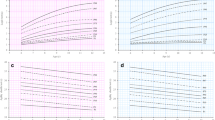Abstract
The aim of the study was to determine factors associated with running time in children aged 12 years, according to sex and sexual maturation of girls. The physical ability was measured, using a 1000 meter run in a group of 942 boys and girls aged 12. In addition, data was collected on family sports activities and the children's sports activities, using questionnaires for parents and children. Before the 1000 meter run, physical examination was carried out. Nutrition habits of the family in the home and outside were self-reported in a questionnaire.
The mean time for run in boys was shorter by 40 seconds than that for girls. Premenarche girls ran significantly faster than postmenarche girls (p > 0.05). The best predictors for short running time were triceps skinfold thickness and sport motivation of the children. Weaker correlation was observed between food variables, family characteristics and running time. The highest prediction of running time by the measured variables was found for postmenarche girls, explained by the high correlation of running time with the behavioral variables. In boys and premenarche girls, the best predictors for running time were the physical and physiological characteristics of the children.
Similar content being viewed by others
References
BorvinG.J., CantionA., CarterB.J. and WilliamC.L. (1979): Reducing adolescent obesity through school health programs. - J. Pediatr 95: 1060–1062.
BrownT.E., MylesW.S. and AllenC.L. (1983): The relationship between aerobic fitness and certain cardiovascular risk factos. - Aviation, Space Environ Med. 54: 543–547.
CooperK.H., PollackM.L., MartinR.P., WhiteS.R., LinnerudA. C. and JacksonA. (1976): Physical fitness levels vs. selected coronary risk factors: A crosssectional study. - JAMA 236 (2): 166–169.
FolsomA.R., CaspersonC.J., TaylorH.L., JacobsD.R., WepkerR. V., Gomez-MarinO.et al. (1985): Leisure time physical activity and its relationship to coronary risk factors in a population-based sample. The Minnesota heart Survey. - Amer. J. Epidemiol. 121: 570–579.
FranklinB.A. and RubenfireM. (1980): Losing weight through excercise. - JAMA 244: 377–379.
FraserG.E., PhilipsR.L. and HarrisR. (1983): Physical fitness and blood pressure in school children. -Circulation 67: 405–412.
FrippR.R., HodgsonJ.L., KwiterovitchP.O., WernerJ. C., SchulerH. G. and WhitmanV. (1985): Aerobic capacity obesity and atherosclerotic risk factors in male adolescents. - Pediatr. 75: 813–818.
GibbsonL. W., BlairS.N., CooperK.H. and SmithM. (1983): Association between coronary heart disease risk factors and physical fitness in health adult women. - Circulation 67: 977–983.
LaPorteR.E., CauleyJ.E., KinseyC.M., CorberW., RobersonR., Black-SandlerR.et al. (1982): The epidemiology of physical activity in children, college students, middle-aged men, menopausal women and monkeys. - J. Chron Dis. 35: 787–795.
MorrisI.N., PollarR., EverittM. G. and ChaveS.P.W. (1980): Vigorous exercise in leisure time: Protection against coronary heart disease. - Lance 2: 1207–1210.
PaffenbergR.S., WingA.L. and HydenR.T. (1978): Physical activity as an index of heart attack risk in Collage Alumni. - Amer. J. Epidemiol. 108: 161–175.
StrongW.B., SpencerD., MillerM.D. and SalechbhaiM. (1978): The physical working capacity of healthy black children. - Am J. Dis Child 132: 244–248.
VikarT.R., ValimakiL, Siren TusanenH., AkerblomH.R., VhariM., DuhlM.et al. (1985): Atherosclerosis precursors in Finnish children and adolescents and leisure-time physical activity. - Acta Pediatr. Scand. 318: 169–180.
WatkinsL.O. and StrongW.B. (1984): The child: when to begin preventive cardiology. - Current Probl Pediatr. 14: 30–31.
WilliamsC.L., CarterB.J., ArnoldsC.B. and WynderE.L. (1979): Chronic disease risk factors among children. The “Know your Body” study. - J. Chron Dis 32: 505–513.
WilsonC., EmansS.J., MansfieldJ., PodolskyC. and GraveE. (1984): The relationship of calculated percent and body fat, sport participation, age and place of residence on menstrual pattern in health adolescent girls at an independent New England High School. - J. Adol. Hlth Care 5: 248–253.
World Health Organisation (1978): Study of the precursors of Atherosclerosis. - WHO/CVD: 78.1.
YarroteP.M., McConaughT.H., GoldmanM.E. and ZuckermanJ.L. (1974): Organisation and evaluation of a physical fitness program in industry. - J. Occ Med. 16: 589–598.
Author information
Authors and Affiliations
Additional information
Corresponding author.
Rights and permissions
About this article
Cite this article
Halfon, S.T., Bronner, S. Determinants of physical ability in 7th grade schoolchildren. Eur J Epidemiol 5, 90–96 (1989). https://doi.org/10.1007/BF00145052
Issue Date:
DOI: https://doi.org/10.1007/BF00145052




